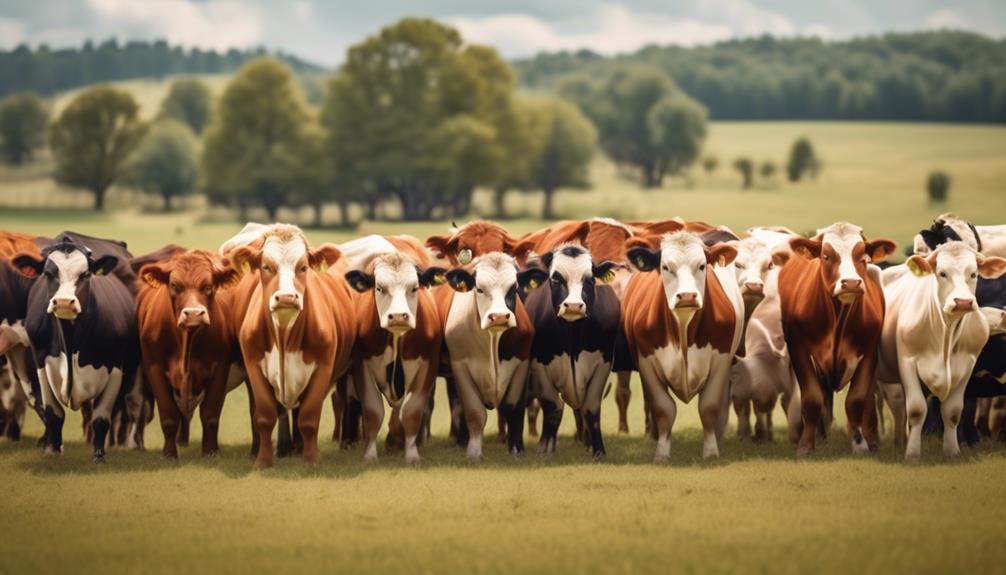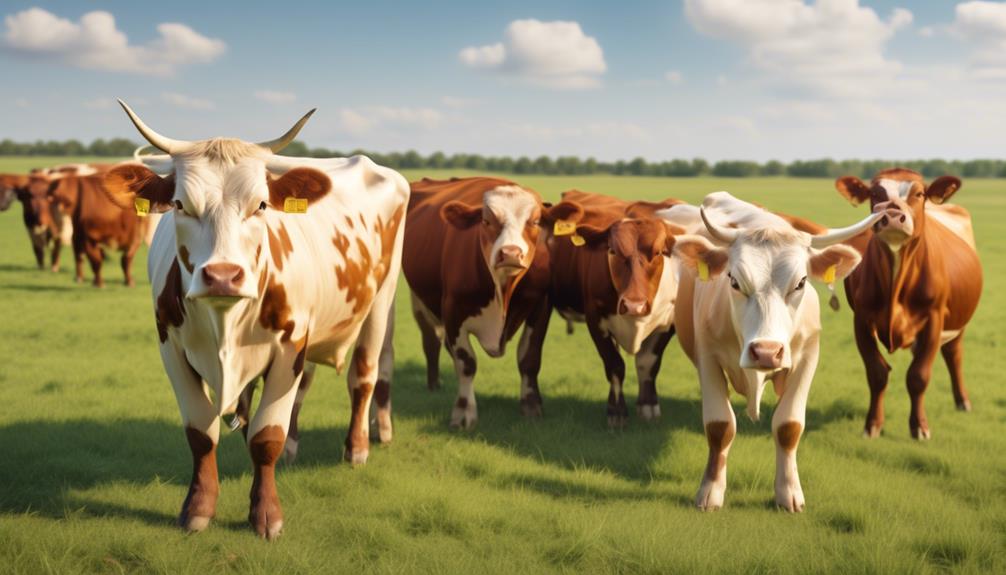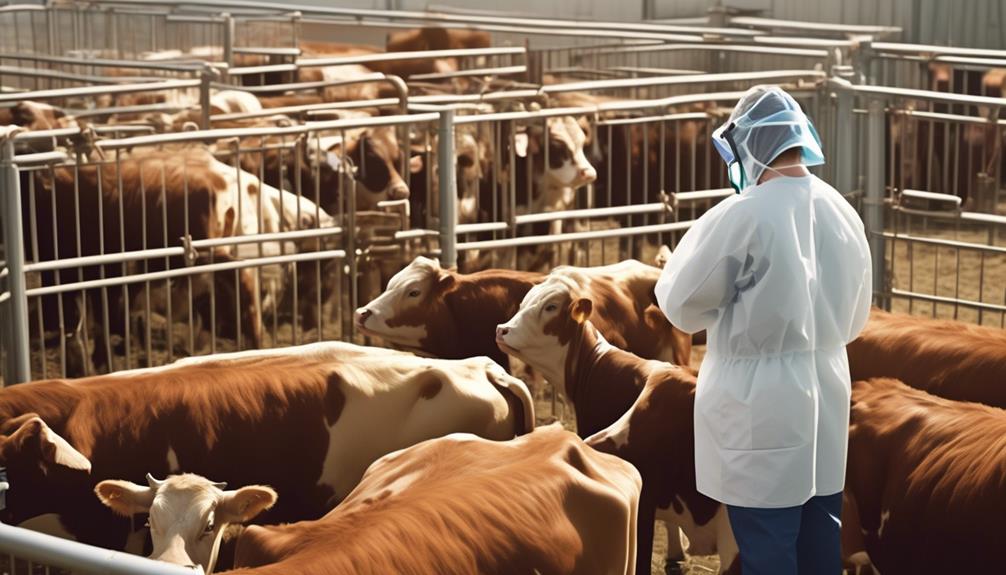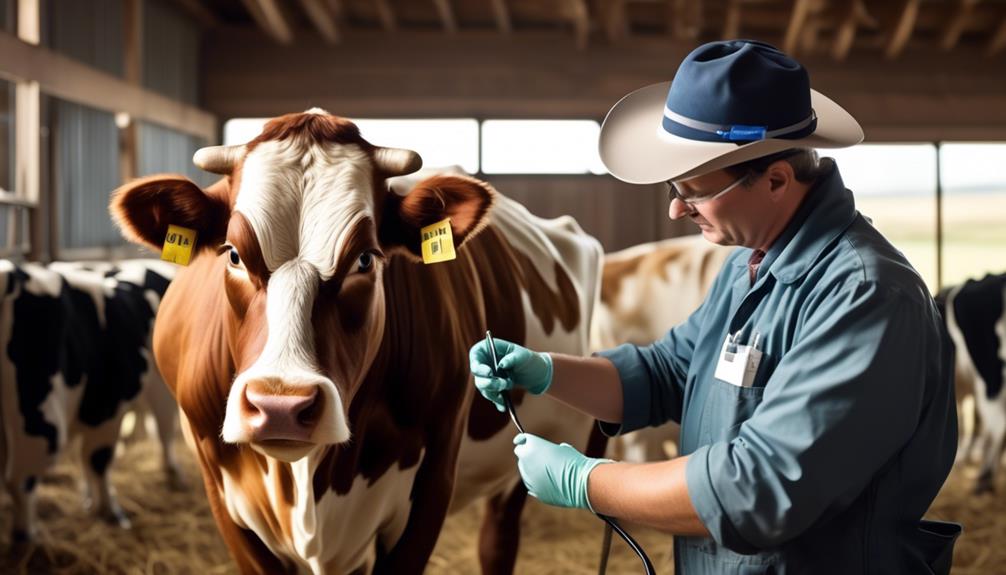5 Essential Tips for Cattle Herd Health Plans
You've heard the saying that 'an ounce of prevention is worth a pound of cure,' and when it comes to managing a healthy cattle herd, this rings especially true. Ensuring the well-being of your cattle is not just about reacting to illness; it's about proactively planning for their health and implementing strategies to prevent disease and maintain optimal conditions.
As a cattle owner, you are constantly juggling various aspects of herd management, but prioritizing their health is paramount. So, where do you start?
Well, here are five essential tips that can help you establish a robust herd health plan and ensure the vitality of your cattle.
Understanding Herd Health Needs

Understanding your cattle herd's health needs is essential for maintaining their well-being and productivity. Grazing management plays a crucial role in meeting the nutritional requirements of your cattle. By rotating pastures, you can prevent overgrazing and ensure that your herd has access to a variety of forage types, promoting their overall health. Additionally, implementing proper grazing management practices can help minimize the risk of parasite infestations and reduce the spread of infectious diseases within the herd.
Disease prevention is a key aspect of maintaining herd health. Vaccinations are an important tool in preventing common cattle diseases. Consult with a veterinarian to develop a vaccination schedule tailored to your herd's specific needs. Regular health checks can also aid in early detection of any potential health issues, allowing for prompt intervention and treatment.
Genetic diversity is essential for the long-term health and resilience of your herd. Consider implementing diverse breeding strategies to maintain genetic variation and reduce the risk of inherited health issues. By selecting breeding stock based on their genetic traits and overall health, you can contribute to the vitality of your herd for generations to come.
Understanding your cattle herd's health needs is a continuous process that requires vigilance and proactive management. By incorporating grazing management practices, disease prevention measures, and genetic diversity considerations into your herd health plan, you can promote the well-being and productivity of your cattle.
Establishing a Vaccination Schedule
To ensure the continued health and well-being of your cattle herd, establishing a vaccination schedule is crucial for preventing common diseases and maintaining their overall productivity. Vaccinations are an essential part of herd health management, and by implementing a well-planned schedule, you can significantly reduce the risk of disease outbreaks and improve the overall health of your cattle.
Importance of a Vaccination Schedule
- Vaccine Effectiveness: Vaccines are most effective when administered at the right time and in the correct manner. Establishing a vaccination schedule ensures that each vaccine is given when it can provide the best protection for your herd.
- Herd Immunity: A consistent vaccination schedule helps in developing herd immunity, where a large proportion of the herd becomes immune to a particular disease, reducing the risk of outbreaks and protecting even those animals that may not be vaccinated.
- Disease Prevention: By following a vaccination schedule, you can effectively prevent a wide range of diseases that could otherwise have serious implications for the health and productivity of your cattle.
Establishing a vaccination schedule requires careful consideration of factors such as the age and breed of your cattle, the prevalent diseases in your region, and the specific needs of your herd. Consult with a veterinarian to develop a customized vaccination plan that aligns with the unique requirements of your cattle.
Implementing Parasite Control Measures

Implementing parasite control measures is essential for safeguarding the health and productivity of your cattle herd. Grazing management and pasture rotation are effective strategies to minimize parasite exposure. By rotating pastures, you can break the parasite life cycle and reduce pasture contamination, ultimately lowering the risk of infection for your cattle.
Additionally, conducting regular fecal egg counts can help determine parasite burdens in your herd. Based on these counts, you can establish a targeted deworming schedule to effectively manage parasite levels, prevent resistance, and optimize the health of your cattle.
When implementing grazing management practices, consider the stocking density and rotation frequency to prevent overgrazing and reduce parasite transmission. Ensure that pastures have adequate rest periods to interrupt the parasite life cycle.
Furthermore, strategic deworming based on fecal egg counts allows for a more targeted approach, reducing unnecessary chemical use and minimizing the risk of developing resistant parasite strains.
Monitoring Feed and Nutrition
Consider assessing your cattle herd's feed and nutrition to ensure optimal health and productivity. Monitoring feed and nutrition is crucial for maintaining the well-being of your herd. Here are some essential tips to help you manage this aspect effectively:
- Feed Analysis: Conduct regular feed analysis to determine the nutritional content of the feed. This analysis will help you understand the quality and quantity of nutrients that your cattle are receiving. By assessing feed quality, you can make informed decisions about adjusting the diet to meet the specific nutritional needs of your herd. It also allows you to identify any deficiencies or excesses in the feed, enabling you to take corrective actions promptly.
- Nutritional Supplements: Consider providing nutritional supplements to address any deficiencies in the feed. These supplements can help ensure that your cattle receive all the essential nutrients necessary for their growth, reproduction, and overall health. Work with a veterinarian or animal nutritionist to determine the appropriate supplements needed based on the results of the feed analysis and the specific requirements of your herd.
- Regular Monitoring: Continuously monitor the feeding practices and the condition of your cattle to ensure that they're receiving adequate nutrition. Regular monitoring allows you to make timely adjustments to the feeding program, preventing any potential health issues related to inadequate nutrition.
Developing Biosecurity Protocols

Ensure the health and safety of your cattle herd by establishing robust biosecurity protocols to prevent the spread of diseases and maintain overall well-being. Biosecurity measures are crucial for protecting your herd from infectious diseases.
Start by implementing strict quarantine protocols for new cattle arrivals. This involves isolating new animals from the rest of the herd for a period of time to monitor their health status and prevent the potential spread of any contagious diseases they may be carrying. During this quarantine period, it's important to closely observe the new animals for any signs of illness and perform necessary testing before integrating them with the rest of the herd.
In addition to quarantine protocols, consider establishing controlled access points to your farm or ranch to limit the entry of unauthorized vehicles and individuals who may inadvertently introduce pathogens to your cattle. This can help minimize the risk of disease transmission from external sources.
Furthermore, develop a vaccination schedule in consultation with a veterinarian to protect your herd against common infectious diseases. Regularly review and update your biosecurity protocols to align with the latest best practices and emerging disease threats in your region.
Managing Reproductive Health
Maintain optimal reproductive health in your cattle herd by incorporating a comprehensive breeding management plan that includes regular estrus monitoring and timely artificial insemination. This is essential for maximizing the breeding efficiency and productivity of your herd.
Here are some key strategies to manage reproductive health effectively:
- Breeding Management: Implement a well-structured breeding program that takes into account the age, weight, and overall health of your cattle. This includes planning for the timing of breeding and calving, as well as ensuring proper nutrition and healthcare during the gestation period.
- Fertility Assessments: Conduct regular fertility assessments to identify any reproductive issues early on. This may involve working closely with a veterinarian to perform reproductive examinations and tests, such as ultrasound scans and semen analysis for bulls, to assess fertility and address any potential concerns promptly.
- Record Keeping: Maintain detailed records of breeding dates, calving histories, and any reproductive interventions. This information is invaluable for tracking the reproductive performance of individual animals and making informed decisions regarding culling, breeding choices, and overall herd management.
Conducting Regular Health Checks

To ensure the overall well-being of your cattle herd and continue their optimal reproductive health, conducting regular health checks is imperative. Preventive care plays a crucial role in maintaining the health of your herd. By conducting routine health checks, you can identify and address potential health issues before they escalate, ultimately saving you time and resources. Regular health checks also enable you to monitor the effectiveness of your preventive care measures, such as vaccinations and deworming, ensuring that your cattle remain in top condition.
Disease detection is another key aspect of conducting regular health checks. Early detection of diseases can significantly impact the outcome and spread of an illness within your herd. By monitoring vital signs, such as body temperature, respiratory rate, and overall behavior, you can swiftly identify any deviations from the norm, prompting further investigation and timely intervention if necessary. Additionally, routine checks for signs of parasites, such as ticks and lice, are essential in maintaining the overall health and comfort of your cattle.
Incorporating regular health checks into your herd management routine not only supports the well-being of your cattle but also contributes to the overall productivity of your operation. By staying proactive and vigilant in your approach to herd health, you can minimize the risk of disease outbreaks and ensure that your cattle thrive in a healthy environment. Regular health checks are an essential component of a comprehensive herd health plan, promoting the long-term success of your operation.
Creating Emergency Response Plans
Incorporate a comprehensive emergency response plan to safeguard the well-being of your cattle herd in unforeseen circumstances. Being prepared for emergencies is crucial for the safety and health of your herd. Here are some key elements to consider when creating an emergency response plan:
- Emergency Evacuation: Develop a clear and actionable plan for evacuating your cattle in the event of natural disasters such as floods, wildfires, or severe storms. Identify safe relocation sites and establish protocols for transporting your herd to these locations. Regularly review and practice the evacuation plan with your team to ensure everyone knows their role and responsibilities.
- Disease Outbreak Management: Create a detailed protocol for managing and containing potential disease outbreaks within your herd. This should include early detection measures, isolation procedures for sick animals, and communication strategies with relevant veterinary authorities. Additionally, establish biosecurity measures to prevent the spread of diseases and consider vaccination strategies to minimize the risk of outbreaks.
- Communication and Coordination: Establish clear lines of communication with your team, neighboring farms, local authorities, and veterinary services. Ensure that everyone knows how to reach each other in case of an emergency, and maintain up-to-date contact information for all relevant stakeholders. Coordination with local emergency services can also be beneficial, as they may provide support during critical situations.
Frequently Asked Questions
How Can I Ensure the Mental Well-Being of My Cattle in My Herd Health Plan?
To ensure the mental well-being of your cattle in the herd health plan, provide mental stimulation through environmental enrichment, such as varied grazing areas, and promote social interaction by grouping compatible animals together for companionship and reduced stress.
What Are Some Effective Ways to Reduce Stress and Anxiety in Cattle?
To reduce stress and anxiety in cattle, observe cattle behavior for signs of distress and implement stress management techniques like providing a comfortable environment, proper nutrition, and handling with care to ensure their well-being.
Are There Any Alternative Methods for Parasite Control That I Can Consider in My Herd Health Plan?
Consider organic treatments like herbal remedies and integrated pest management for parasite control in your herd health plan. These alternative methods provide biological control and can be effective in reducing the use of chemical treatments.
How Can I Incorporate Natural Supplements Into the Feed and Nutrition Plan for My Cattle?
You can incorporate natural supplements into your cattle's feed and nutrition plan for optimal health. Consider adding products like probiotics or herbal remedies to support their well-being. Consult with a vet for specific recommendations.
What Are Some Strategies for Handling Unexpected Emergencies, Such as Natural Disasters, in My Herd Health Plan?
When handling unexpected emergencies in your herd health plan, focus on emergency response and disaster preparedness. Implementing protocols for evacuation, emergency medical care, and communication can help mitigate the impact of natural disasters on your cattle.
Conclusion
Now that you have these essential tips for cattle herd health plans, you can ensure the well-being and productivity of your herd.
By understanding their health needs, establishing a vaccination schedule, implementing parasite control measures, monitoring feed and nutrition, developing biosecurity protocols, managing reproductive health, conducting regular health checks, and creating emergency response plans, you can proactively care for your cattle and prevent potential health issues.
